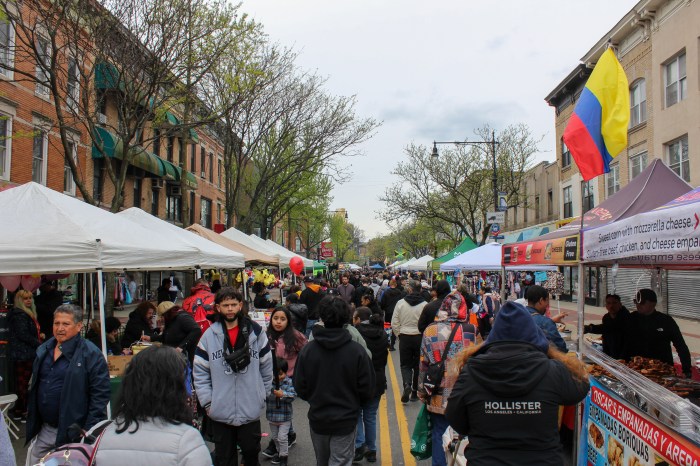By Philip Newman
Queens has long been known as America’s most ethnically diverse place, but new U.S. Census figures confirm it: 46 percent of the borough’s people are foreign born, including multitudes that arrived in the past decade.
Queens Borough President Helen Marshall has appealed to Washington for help in coping with the influx of people from other lands.
“My hope is that the federal government takes a long, hard look at these figures and recognizes the enormous role that New York City played in welcoming more than one million immigrants to this great city since 1990,” Marshall said in reaction to the latest Census figures.
Marshall said the federal government had an obligation “to help us shoulder their burden of overcrowded schools, a lack of affordable housing and strained infrastructure and transportation systems.”
New York City’s foreign-born total of 36 percent is the highest since 1910 in the days of the massive flow of immigrants arriving at Ellis Island. The new Americans, including tens of thousands arriving since 1999, have revitalized many declining neighborhoods of Queens and other parts of the city.
The Queens borough president’s office says the borough’s residents come from 117 countries and speak 167 languages.
The new Census report paints a fascinating mural of life in Queens and its people, including figures on everything from housing costs, poverty, how borough residents get to work and how long it takes to get there, car ownership, age, education, poverty and marital status.
In a disturbing trend, the Census also found that during the 1990s when prosperity seemed so pervasive for so many, Queens’ median household income fell by 4.3 percent from $44,368 to $42,439 for the steepest decline of any borough.
Manhattan was the only borough where income rose.
As to the immigrants of Queens, the Census reported that 51 percent spoke no English at home with 45 percent speaking Spanish and 55 percent other languages. Fifty-four percent said they did not speak English “very well.”
Other Census facts (all figures are for 1999):
• Queens had 817,250 housing units, 5.7 percent vacant with 31 percent single unit houses, 69 percent multi-unit structures and less than 5 percent mobile homes. Forty-eight percent of dwellings were occupied by owners, A total of 0.3 percent of living spaces lacked plumbing or kitchens and 1 percent lacked telephones.
• The median monthly housing costs for owners with a mortgage was $1,621, for non-mortgaged owners $450 and renters $786.
• Thirty-four percent of residents had no access to a car, truck or van for personal use, 19 percent had two cars and 5 percent had three or more vehicles.
• Queens had an 11 percent poverty rate with people over 65 making up 10 percent of those in poverty and female-headed households accounting for 18 percent and children 15 percent.
• As to the age ranges of Queens residents, [people 65 and over accounted for 14 percent of the population; 45-64 — 21 percent; 25-44 —- 33 percent; 18-24 — 10 percent and those under 18 — 23 percent.
• Queens has 2,202,506 residents, including 1,142,129 females and 1,060,377 males. The median age is 35.3.
• Seventy-five percent of Queens residents 25 and older had at least a high school diploma, and 24 percent had a bachelor’s degree or higher. Among those 16 to 19, 10 percent were school dropouts.
• Nine percent of the people of Queens had graduate or professional degrees, 15 percent a college bachelor’s degree, 5 percent an associate degree, 18 percent had some college, 28 percent a high school diploma and 25 percent less than a high school diploma.
• Queens school enrollment was 557,894, including pre-primary of 60,065; elementary to high school, 347,496; and college, 150,333.
• Fifty-two percent of residents take public transit to work, 31 percent drive to work alone, 8 percent car pool and 1 percent work at home. The average commute from Queens takes 41 minutes.
• Twenty-six percent of households received Social Security with an average annual payment of $11,580.
• Employment of Queens workers: Construction 5 percent, manufacturing 9 percent; wholesale trade 3 percent, retail 9 percent, transportation and warehousing and utilities 8 percent, information 4 percent, finance, insurance, real estate and rental and leasing 11 percent, professional and business services 12 percent, educational, health and social services 19 percent, leisure and hospitality 10 percent, other services except public administration seven percent, public administration 5 percent.
• There were 296,933 males who had never married, 460,762 people married, 19,110 separated, 21,901 widowed and 46,244 divorced. There were 276,501 never-married females, 430,098 married, 41,404 separated, 115,327 widowed and 74,514 divorced.
Reach contributing writer Philip Newman by e-mail at Timesledgr@aol.com or call 229-0300, Ext. 136.

































